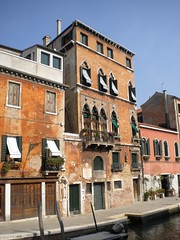Sior Rioba an enigmatic Venetian figure
/Shadows and Secrets: The Timeless Enigma of Rioba and Campo de Mori
In the heart of Venice, where canals breathe life into the city's ancient bones, the still gaze of the Rioba Statue falls over Campo de Mori. Captured in the stark contrasts of black and white, the image transcends mere aesthetics—it taps into the soul of a Venice that exists beyond the reach of time.
The Rioba Statue, renowned for its mysterious visage—a grimace or a smile depending on the eye of the beholder—stands as if whispering secrets to passersby.
The statue of Sior Antonio Rioba is a fascinating subject steeped in Venetian folklore and history. Located in Campo dei Mori in the Cannaregio district, the statue is one of four figures that represent the Mastelli brothers—merchants from the Morea (now part of modern Greece) who settled in Venice during the 12th century. Among the brothers, Sior Antonio Rioba is the most famous and has come to embody various myths and stories over the years.
One of the most popular tales suggests that the statue served as a sort of "complaint box" for Venetians. People would stick notes or messages into the statue's mouth to share grievances, which would then allegedly be reviewed by the Venetian government. It is said that this is where the Venetian phrase "Parlar col Rioba" (Talking to Rioba) originates, implying the action of speaking without being heard or of making a complaint to an indifferent authority.
The statue's face was vandalized in the 19th century, losing its nose and jaw. It has since been restored, but the incident only added to its aura of mystery and intrigue. In more recent times, it's become a symbol of Venice's complex past and its multifaceted relationship with trade, power, and oriental influences.
The statue is made of a composite material resembling bronze, and its countenance—whether viewed as a smile or a grimace—invites multiple interpretations, adding another layer to its enigmatic appeal.
The Campo dei Mori itself has its colourful history, meaning "Field of the Moors," and serves as a lasting testament to Venice's diverse, cosmopolitan past. The square is adorned with various oriental elements, reflecting the city's longstanding trade relationships with the East.
So, if you're capturing this fascinating subject through the lens of your camera, you're not just photographing a statue but an enigmatic figure entwined with the myths, legends, and history of Venice itself.












